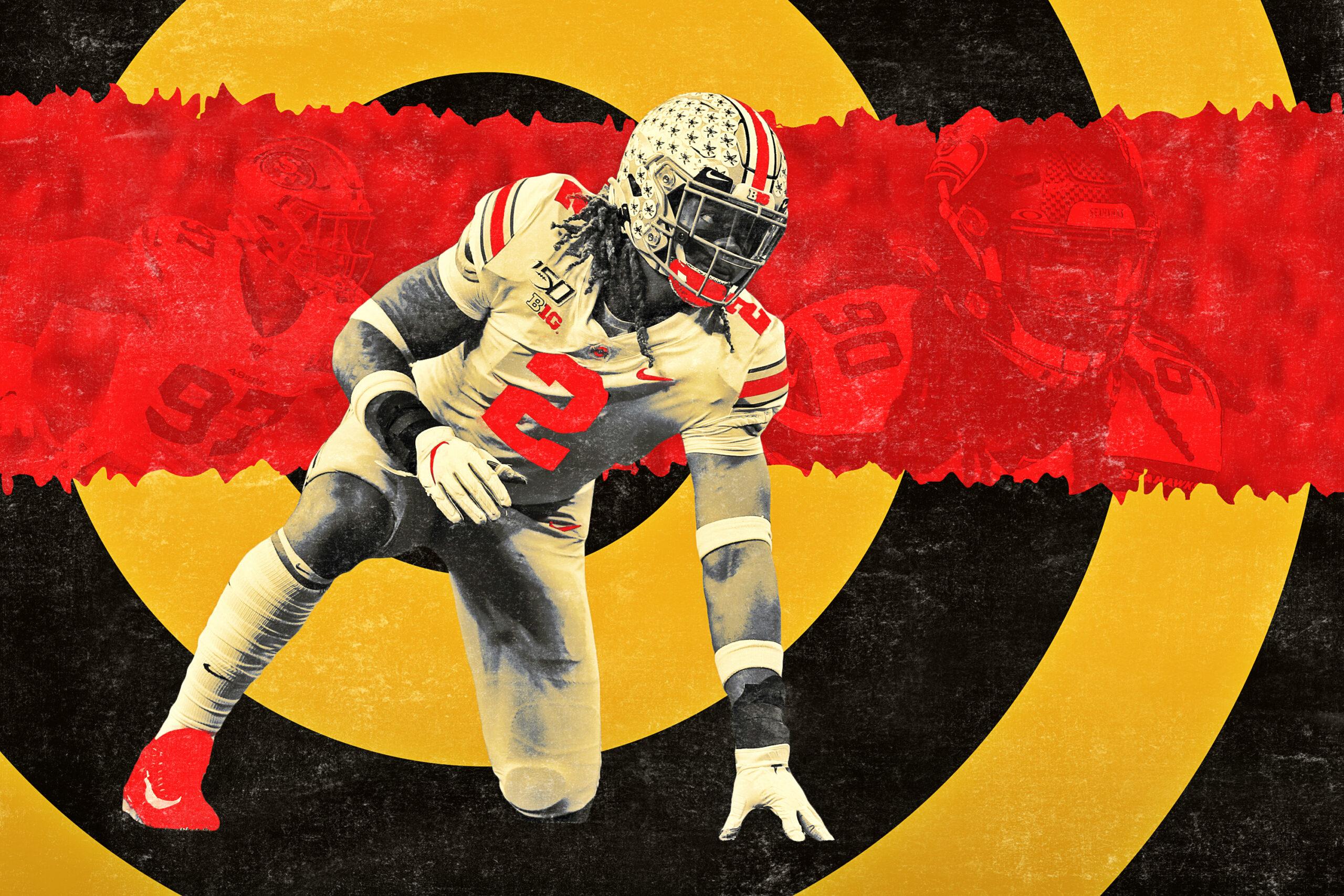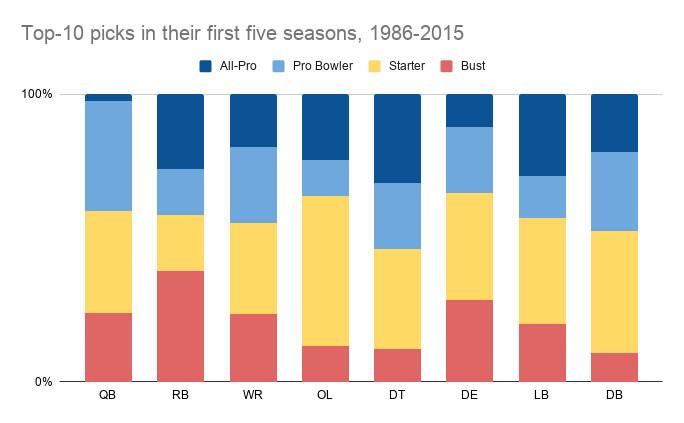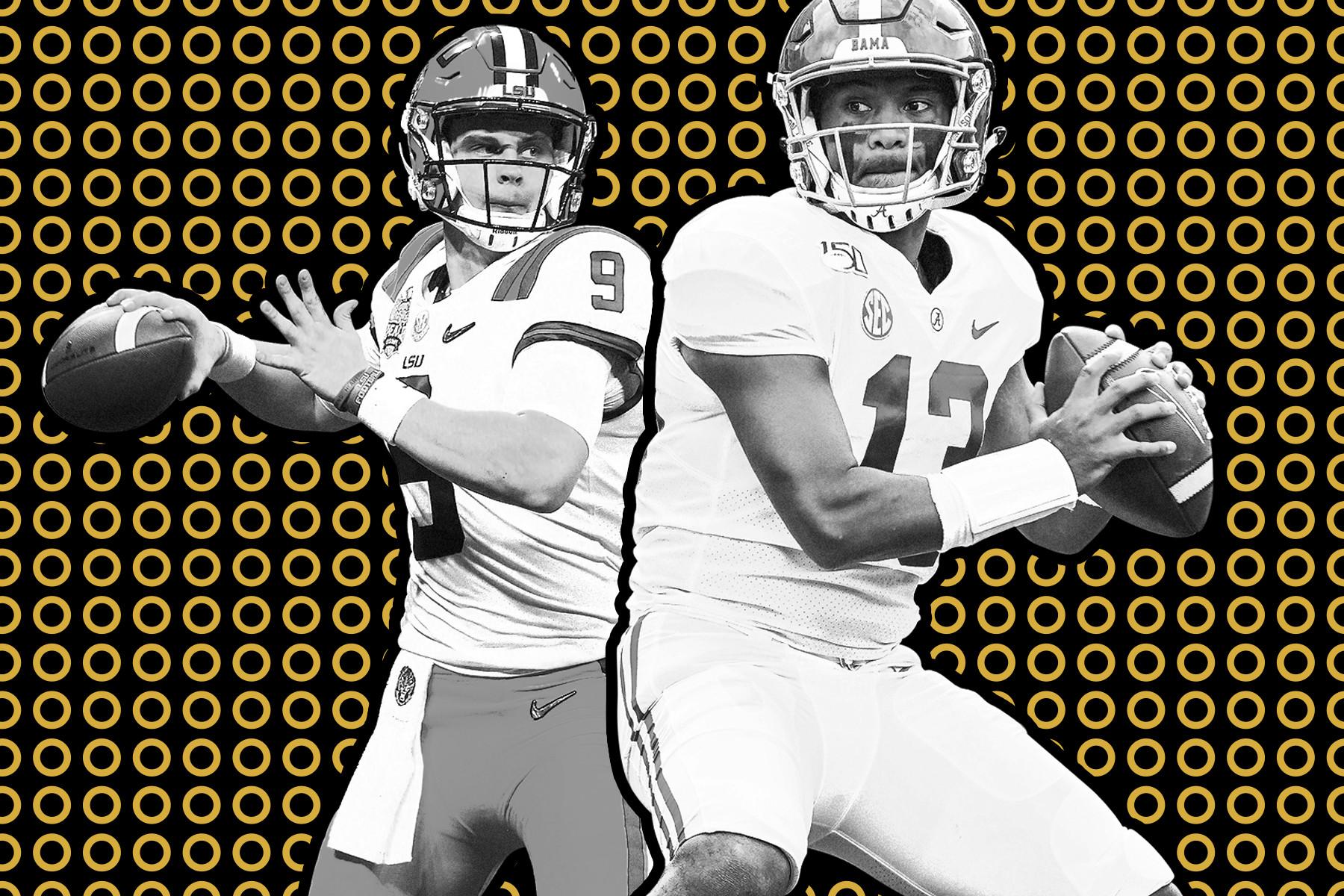
Joe Burrow will almost assuredly be the no. 1 pick in the 2020 NFL draft, but few experts think he’s the best player available. On big board after big board, Ohio State’s Chase Young holds the top spot. Draft gurus have said they’d take him no. 1, that he’s a generational talent, a can’t-miss guy, a rare prospect—the praise goes on and on. Burrow is the best quarterback in this class, which gives him the most upside and the highest potential value for teams. But the awards for safest pick and most complete prospect belong to Young.
Young’s spot at the top of draft boards is the latest example of a recent trend. In five of the past six drafts, the first non-quarterback off the board has been an edge rusher. Last year, it was Nick Bosa. In 2017, Myles Garrett was the consensus top prospect, and he actually went no. 1. Joey Bosa held that position in 2016. Dante Fowler Jr. was the first name called after Jameis Winston and Marcus Mariota in 2015. Jadeveon Clowney looked like a truly generational prospect in 2014. The only miss in this era was 2018, when Bradley Chubb when no. 5 behind Baker Mayfield, Saquon Barkley, Sam Darnold, and Denzel Ward.
Since 2005, there was only one year when a defensive lineman did not go in the top five picks (2012). Outside of quarterback, no other position has dominated the top of recent draft boards the way defensive linemen have—and Young looks to continue that trend this year.
Why is this the case? Are there just that many great defensive linemen, or is something else going on here?
My first theory was that defensive linemen are the safest players in the draft. Look at those names above—most of those guys have gone on to become stars, or are seemingly on their way to stardom. The logical conclusion is that if risk-averse teams want an instant-impact player, they should just take the top pass rusher on the board rather than gamble on a more volatile position. But that list of names represents a stunningly small sample size, and a closer look at history indicates that this theory probably isn’t true.
A 30-year sample of top-10 picks—from 1986 to 2015—shows that defensive linemen are no surer to find success than prospects at other positions. Here’s a look at how top-10 picks have performed in their first five seasons in the league (i.e., roughly the length of time that players are on a rookie contract, and when they are most likely to still be on the team that drafted them), grouped by position:

In this graphic, an All-Pro is any player who was awarded the Associated Press’s first-team All-Pro honors within his first five seasons. A Pro Bowler is a player who only made the Pro Bowl in those seasons. A starter is a non–Pro Bowler who started at least 40 games (i.e., half of all available games). And a bust is a player who started fewer than 40 games.
There’s some statistical noise to these results, sure (would you guess that the only All-Pro quarterback in this group is Cam Newton?). But with 300 players in this sample, it’s large enough to give us some real-world conclusions. Based on this sample, it’s clear that defensive linemen are no surer bets than any other players. If anything, defensive ends look like one of the riskiest options available, as they have the second-highest bust rate (29 percent) and second-lowest All-Pro rate (11 percent). Defensive tackles do quite a bit better, but most of the hyped line prospects are pass rushers, not interior players.
Another theory is that there’s just positional appeal for pass rushers. This graphic clearly shows that quarterbacks aren’t safe picks—which fans and experts alike accept as common knowledge—yet passers still go near the top of the draft because of the value attached to quarterbacks. Are pass rushers simply the other side of that coin?
Conventional wisdom says that football is won in the trenches—and pass rushers are essentially playing offense even though they’re on defense. They attack the offensive line, which is really defending the quarterback, and they’re able to swing drives all on their own. But again, the reality is far more complex.
A large Pro Football Focus data study last year indicated that it’s actually coverage, not pass rush success, that is most important for overall defensive success. A quarterback has a lot of control over how much pressure he faces, and an offense can use many strategies (such as rollouts and quick passes) to mitigate the threat posed by a dominant defensive line. But if receivers can’t get open, there are fewer options available for an offense. Other analyses have offered similar results, and the NFL could be on the precipice of a shift in the way it thinks about pass rushers as a whole.
Despite this, folks are still falling in love with Young, and it’s easy to see why. He racked up 27 sacks in the past two seasons at Ohio State, setting the school’s single season record (16.5) in 2019. He has a combination of power and quickness along with a polished technique that makes him seem like a plug-and-play pass rusher at the next level.
This mirrors the evaluations of many other top defensive line prospects in the past few years. Playing this position takes skill, of course, but the foundation of any great pass rusher is an abundance of physical tools. Often the best defensive lineman in the draft is also just the best athlete. Star pass rushers are typically huge, ripped, fast dudes that jump off the page, whether they’re at the NFL combine or in an actual game. Maybe that makes them a bit more straightforward to evaluate—and as a result, they come off the board sooner.
None of this is a reason to not draft Young. Right now, Washington, the owner of the no. 2 pick in the draft, is in prime position to land the star pass rusher. If the team does take Young, he’ll join a defensive line that is already stacked. The Redskins have spent first-round picks on defensive line talent three seasons in a row in Montez Sweat, Da’Ron Payne, and Jonathan Allen. Payne and Allen both cut their teeth at Alabama, while Sweat hails from Mississippi State.
Adding Young to the mix could put Washington’s line over the top in the same way that Nick Bosa unlocked the 49ers’ vaunted pass rush last season. San Francisco already had skilled linemen in DeForest Buckner and Arik Armstead, but it was the adrenaline shot provided by Bosa’s Defensive Rookie of the Year campaign that vaulted the Niners’ defense from 23rd in DVOA in 2018 to second and helped carry the team to the Super Bowl. (Though it’s worth noting that San Francisco’s excellent coverage unit was also a huge part of that success, and Washington’s secondary is bare—so keep expectations for Washington in check.)
Someday soon, the league’s infatuation with pass rushers may come to an end, but we’re still in the early days of the pass rush vs. coverage debate. This year, Young holds the crown as the best pass rusher—and best prospect—in the draft. How long this trend will continue, though, remains to be seen.


